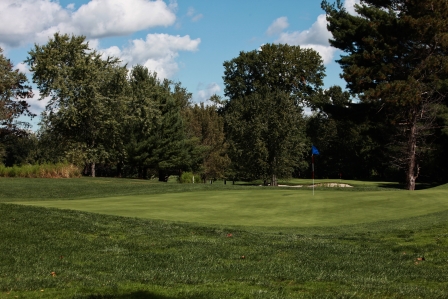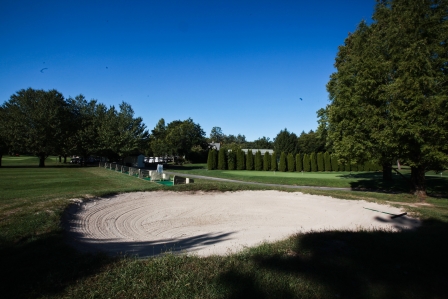Paramus Golf Club, located at 314 Paramus Road in Bergen County, New Jersey, has become a local favorite for public play and has recently earned recognition as the Best Golf Course in the county for 2024. This recognition didn’t happen by chance. It reflects years of consistent effort, in-house renovations, and daily management decisions made by its Superintendent and General Manager, Andy Schuckers.

The Superintendent’s Role: More Than Mowing Grass
If you ask most players what makes a round memorable, they might mention pace of play, putting greens, or a smooth tee-to-green experience. What they may not consider is the impact of the golf course superintendent—a professional whose fingerprints are on nearly every blade of grass.
Andy Schuckers has been a Golf Course Superintendent for more than 30 years. His journey started at Penn State University, where he studied Turfgrass Management while working at the Blue and White Golf Course. “I started at the Penn State Blue and White Golf Course,” Andy recalls. “I went to Penn State for Turfgrass.” Before arriving in Paramus in 2011, Schuckers sharpened his skills at Meadows Golf Club in Lincoln Park and Darlington Golf Course in Mahwah.

He credits Bob Hudzick, then superintendent of Penn State’s 36-hole course and manager of all grounds and athletic fields, as his earliest mentor. “He inspired me with how he handled both responsibilities and staff with calm leadership.”
At Paramus Golf Club, Schuckers wears two hats: Superintendent and General Manager. His approach is hands-on. He oversees all maintenance programs, staff coordination, and course improvements. And he does it all with a singular goal: to improve the golfer’s experience without breaking the municipality’s budget.
The course itself has a storied past. Built in 1928, it originally opened as Saddle River Golf Club before being purchased in 1976 by the Borough of Paramus. Today, it’s a municipal course that plays more like a private club thanks to thoughtful management and community support.
Equipment Choices That Shape the Greens
One of the most powerful decisions a superintendent makes involves equipment. Schuckers has praised tools like the Thatch-Away system, calling it the best greens maintenance tool he’s used in his career. In his own words, “The quality of the putting surface is improving with each use. I am not sure how I ever did my job without it.”
When asked to name a favorite piece of equipment, he didn’t hesitate: “Ventrac with any attachment.” That kind of versatility is essential, especially when dealing with varied terrain, storm damage, and seasonal shifts in the Northeast.

In a GCSAA TV interview, Schuckers described how the club handles storm damage. The course uses an audible lightning detection system to ensure player and staff safety. It alerts everyone when lightning is within 10 miles and gives the all-clear when danger passes. This level of preparedness ensures minimal disruption while maintaining safety standards.
Turf Practices That Matter
Rolling and brushing greens, as covered in a recent Golf Course Industry article, have proven benefits in suppressing diseases like dollar spot and enhancing putting quality. At Paramus, such techniques are standard. The club doesn’t rely heavily on verticutting but rather integrates brushing to manage grain and improve surface consistency.
This isn’t just about playing conditions. It’s about balancing labor, budget, and turf health. Research from Michigan State shows that rolling greens can actually reduce disease pressure while minimizing mechanical stress. When you next play a smooth round at Paramus, there’s a good chance that attention to these practices is why.
Schuckers shared that renovations at Paramus are completed in-house, including bunker updates and the addition of several new forward tees. These projects aren’t flashy but are vital to improving overall course accessibility and enjoyment.

The Personality Behind the Position
Day-to-day motivation often comes from the regular golfer. “Compliments from everyday golfers keep me motivated,” Schuckers said. What gets under his skin? “Politics. Uneducated people who think they know how to run a golf course.”
When asked about a favorite hole, he pointed to #17. “It’s a long, difficult uphill par three. Definitely the most challenging on the course.”
Despite his role as both GM and Superintendent, tournaments aren’t a major focus. “None! We play golf seven days a week,” he noted.
Off the course, Schuckers values time with his family. “I have three kids and three grandkids! In my spare time, I enjoy playing with old cars.”
Community Integration
Paramus Golf Club isn’t just a facility; it’s part of the community. The club features a New Jersey-themed mini-golf course and is involved with the Paramus Public Library and other civic groups. Schuckers supports these outreach efforts and views golf as something to be shared, not just played.
You might not expect a course superintendent to be deeply involved in civic engagement, but it makes sense. Golf courses often serve as community spaces, and maintaining a public course involves more than turf. It involves people.
Small Changes, Big Outcomes
Some of the most impactful renovations under Schuckers’ leadership have been relatively simple: reworking bunkers, adding forward tees, and fine-tuning mowing patterns. These aren’t headline projects, but they significantly affect playability and pace.
Are you a mid-handicap player who prefers faster greens? Or do you appreciate a well-maintained fairway that rewards smart tee shots? Either way, these upgrades have a direct impact on your round.
Forward tees make the course more playable for seniors, juniors, and higher-handicap players. Bunker positioning and maintenance shape how aggressively you can play into greens. Everything is interconnected, and the superintendent is at the center.
Lessons for Golfers and Industry Professionals
If you’re a player, the takeaway is this: next time you’re impressed by course conditions, think about the planning, staffing, and problem-solving that happens behind the scenes.
If you’re in the golf industry, particularly as an up-and-coming superintendent, Schuckers’ career is worth studying. His approach to equipment choice, storm preparedness, and community involvement can serve as a blueprint.
What tools do you rely on that you couldn’t do your job without? Are there simple, overlooked course improvements you could implement with your existing resources? Have you built relationships outside your core staff to strengthen your facility’s value in the community?
Final Thoughts
The next time you tee it up at Paramus Golf Club, take a moment to look beyond the flagstick. Consider the infrastructure, strategy, and human effort required to create the playing field in front of you.
Behind that quiet morning dew and freshly cut fairway is a Golf Course Superintendent named Andy Schuckers. His decisions—from the tools he selects to the tees he adds—don’t just maintain the course; they define it.
And if you’re someone who appreciates both the game and the setting it’s played on, knowing who’s behind it all might just change how you play your next round.











